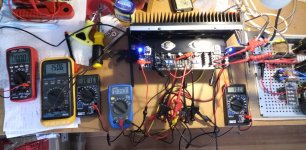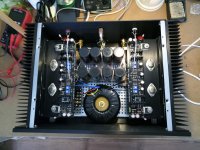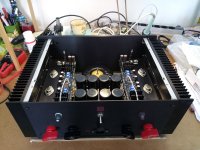update
my quick update...
VFETs are now in place. after approx. 1h warm up , following values could be set:
R5: 1506 mV
R6: 1516 mV
R31: 0-30mV
R32: 100mV
output DC: 14mV
I am going to build the other channel during the next days and then check the sound
many thanks to you all, especially nelson, for this nice project and all the support.
cheeers
my quick update...
VFETs are now in place. after approx. 1h warm up , following values could be set:
R5: 1506 mV
R6: 1516 mV
R31: 0-30mV
R32: 100mV
output DC: 14mV
I am going to build the other channel during the next days and then check the sound
many thanks to you all, especially nelson, for this nice project and all the support.
cheeers
Attachments
hi everybody,
today i finished the amp. i measure followings:
cold (after 1 minute):
..............left channel / right channel
output DC: 90 mV / 61 mV
R31(T18): 212 mV / 370mv
R32: 106 mV / 107 mV
warm after 45 minutes:
............left channel / right channel
output DC: 20 mV / 8 mV
R31(T18): 1 mV / 1 mv
R32: 100 mV / 102 mV
I think these values are ok. But for the PSU I measure with both channels connected just 26,7 V. (with one channel it was 29,5 V ). the voltage drop over the R19 and R20 is 2,7 V which should still be sufficient according to Nelson. However, before I go forward and connect the speakers , I want to make sure if there is any need for further actions? any suggestions?
thanks and regards
today i finished the amp. i measure followings:
cold (after 1 minute):
..............left channel / right channel
output DC: 90 mV / 61 mV
R31(T18): 212 mV / 370mv
R32: 106 mV / 107 mV
warm after 45 minutes:
............left channel / right channel
output DC: 20 mV / 8 mV
R31(T18): 1 mV / 1 mv
R32: 100 mV / 102 mV
I think these values are ok. But for the PSU I measure with both channels connected just 26,7 V. (with one channel it was 29,5 V ). the voltage drop over the R19 and R20 is 2,7 V which should still be sufficient according to Nelson. However, before I go forward and connect the speakers , I want to make sure if there is any need for further actions? any suggestions?
thanks and regards
Attachments
hi zen mod, bare and dennis,
many thanks for the feedbacks. i will go and connect the amp to speakers today
indeed, the situation changed as i put the lid on i had to re_adjust the settings again. the amp gets almost stable after 60 minutes ;-)
i had to re_adjust the settings again. the amp gets almost stable after 60 minutes ;-)
i get following settings now with the lid on (please see the attached image).
@bare: the vaseline was used for a plaster cast . but maybe i could give it a try and oil the VFET engines too :-D
. but maybe i could give it a try and oil the VFET engines too :-D
i was lucky to have/find some DMMs. they were very helpful for setting the amp. i was propably lost if i had to do it with just one DMM . as a matter of fact, i use 6x DMMs to set the amp with the lid on :-D
. as a matter of fact, i use 6x DMMs to set the amp with the lid on :-D
i will report when the amp is playing music ;-) . many thanks again!
best regards
many thanks for the feedbacks. i will go and connect the amp to speakers today
indeed, the situation changed as i put the lid on
i get following settings now with the lid on (please see the attached image).
@bare: the vaseline was used for a plaster cast
i was lucky to have/find some DMMs. they were very helpful for setting the amp. i was propably lost if i had to do it with just one DMM
i will report when the amp is playing music ;-) . many thanks again!
best regards
Attachments
update
update:
the amp plays music very nicely, dynamic, transparent with a dark background.
very nicely, dynamic, transparent with a dark background.
let me give him around 100h of playing time before i compare it to my single-ended 300b ;-)
at this stage may i send again lot of thanks to everybody, especially to nelson and the diyaudio team for making this experience possible!
best regards
update:
the amp plays music
let me give him around 100h of playing time before i compare it to my single-ended 300b ;-)
at this stage may i send again lot of thanks to everybody, especially to nelson and the diyaudio team for making this experience possible!
best regards
Quick question guys. I cheated and bought one of these amps pre-built from a DIYer who was looking to offload a few of their self made amps. I'm coming from a Parasound Halo A21 which only does about 8 watts of pure class A before going to A/B. So I was expecting this amp to run hotter. But how hot is too hot? I'm measuring ~115 degrees F (44C) at the edge of the heatsink fins and ~130 degrees F (54C) at the base of the fins where they attach to the side wall of the aluminum chassis. The faceplate and rest of the amps outside surface area are also around 115 degrees F. Is all of this within "normal" operating temperatures? It just barely passes the 5 second rule that I've read about.
Quick question guys. I cheated and bought one of these amps pre-built from a DIYer who was looking to offload a few of their self made amps. I'm coming from a Parasound Halo A21 which only does about 8 watts of pure class A before going to A/B. So I was expecting this amp to run hotter. But how hot is too hot? I'm measuring ~115 degrees F (44C) at the edge of the heatsink fins and ~130 degrees F (54C) at the base of the fins where they attach to the side wall of the aluminum chassis. The faceplate and rest of the amps outside surface area are also around 115 degrees F. Is all of this within "normal" operating temperatures? It just barely passes the 5 second rule that I've read about.
55C degrees is considered normal for Firstwatt amplifier. Some including myself push 60C to 65C without any problem.
I think the most practical way to go about it wouldn't be a fan underneath the amp. My VFet amp is housed in First Watt clone chassis. So I'm going to try and mount a fan on the back side of the chassis blowing air down each of the heatsink fins. I think this would work quite well and very efficiently cool it.
I'm going to buy two Noctua NF-S12A ULN fans. They're rated for only 8.6dB and still move a lot of air. I can find a cheap 2 amp 12volt DC power supply with a molex connector. Then I just need a molex to two port 3-pin fan adapter. I can do all of this for about $50. I'll probably end up spray painting the fans matte black. The only thing I haven't though of is how I'm going to affix the fans to the back of the amp. I want to avoid glue. I may just build a cheap stand for each fan and have them behind the amp instead essentially butted up against each heatsink.
Items Needed:
Amazon.com: Noctua 120mm, 2 speed setting Anti-Stall Knobs Design SSO2 Bearing Case Cooling Fan NF-S12A ULN: Computers & Accessories
Amazon.com: AC Adapter Hard-Disk Power Supply For Hard Disk Drive Black 12V+5V: Home Audio & Theater
EnLabs LP422TX425CM 10 inch Black Sleeved 4pin IDE Molex to 2 Ports 3Pin/4Pin PWM Fan Power Splitter Adapter Cable - 12V DC Only - Newegg.com
I'm going to buy two Noctua NF-S12A ULN fans. They're rated for only 8.6dB and still move a lot of air. I can find a cheap 2 amp 12volt DC power supply with a molex connector. Then I just need a molex to two port 3-pin fan adapter. I can do all of this for about $50. I'll probably end up spray painting the fans matte black. The only thing I haven't though of is how I'm going to affix the fans to the back of the amp. I want to avoid glue. I may just build a cheap stand for each fan and have them behind the amp instead essentially butted up against each heatsink.
Items Needed:
Amazon.com: Noctua 120mm, 2 speed setting Anti-Stall Knobs Design SSO2 Bearing Case Cooling Fan NF-S12A ULN: Computers & Accessories
Amazon.com: AC Adapter Hard-Disk Power Supply For Hard Disk Drive Black 12V+5V: Home Audio & Theater
EnLabs LP422TX425CM 10 inch Black Sleeved 4pin IDE Molex to 2 Ports 3Pin/4Pin PWM Fan Power Splitter Adapter Cable - 12V DC Only - Newegg.com
Last edited:
do it in your own way ...... though , I made Babysitter as sort of universal solution
cheap too ....... generic 12cm fan , scavenged from dead PC PSU
mobile phone charger ....... pretty much anything can be used for fan power
Noctua is overkill ....... wise to use where you need more wind , but this is where you need 5-10C difference , and this setup is doing the work
if possible - try to make it in cheapskate way then , if not satisfied , invest in more efficient solution
cheap too ....... generic 12cm fan , scavenged from dead PC PSU
mobile phone charger ....... pretty much anything can be used for fan power
Noctua is overkill ....... wise to use where you need more wind , but this is where you need 5-10C difference , and this setup is doing the work
if possible - try to make it in cheapskate way then , if not satisfied , invest in more efficient solution
- Home
- Amplifiers
- Pass Labs
- Sony vFET Illustrated build guide



